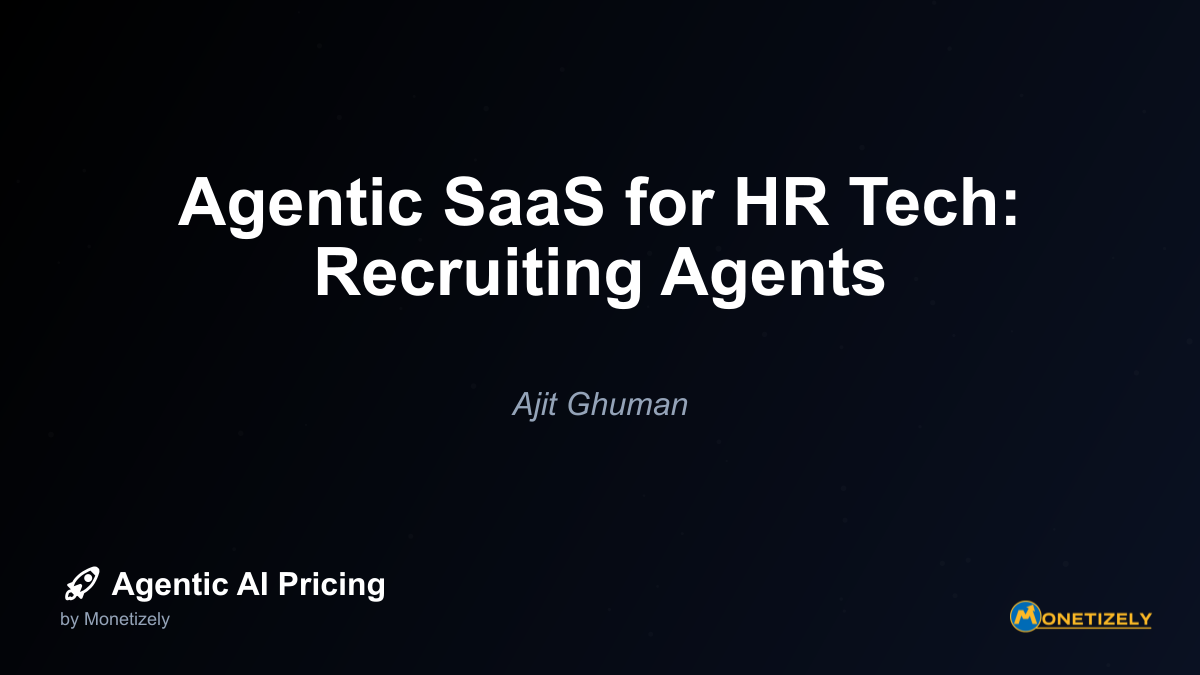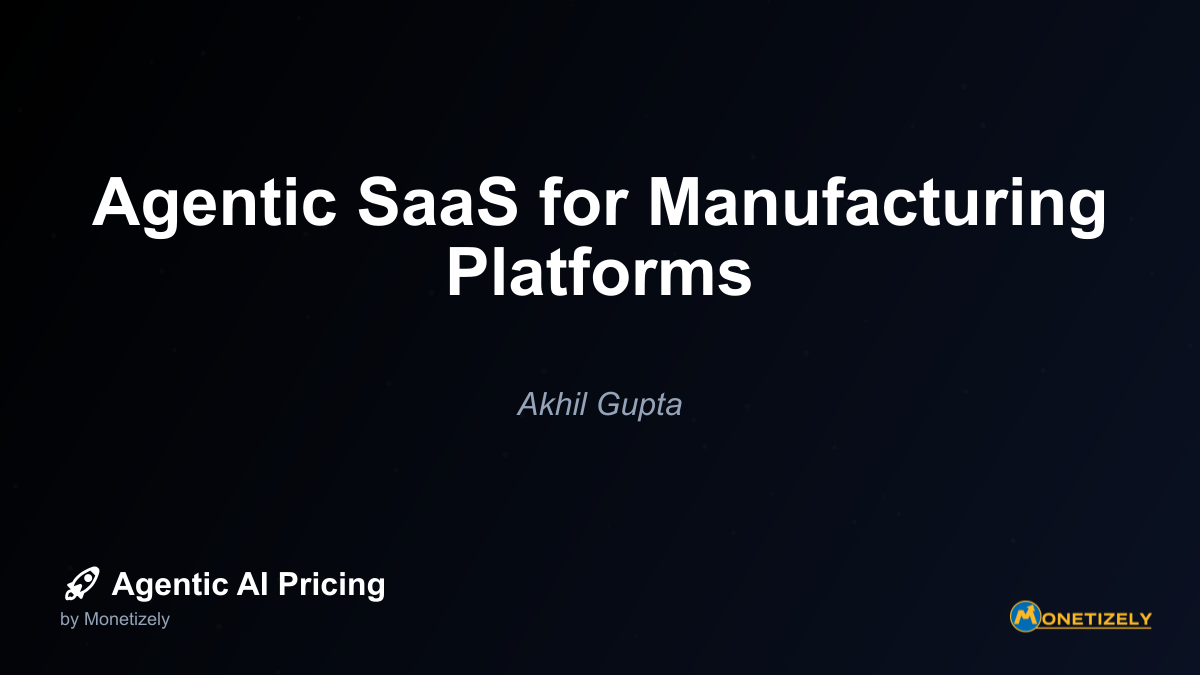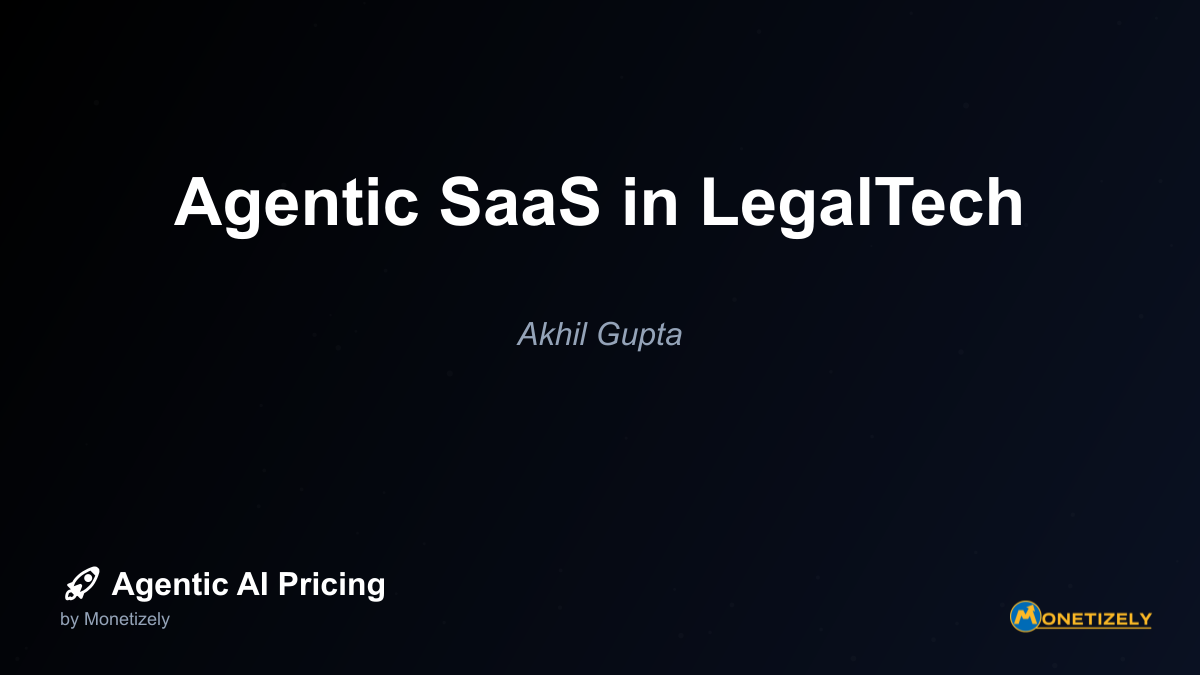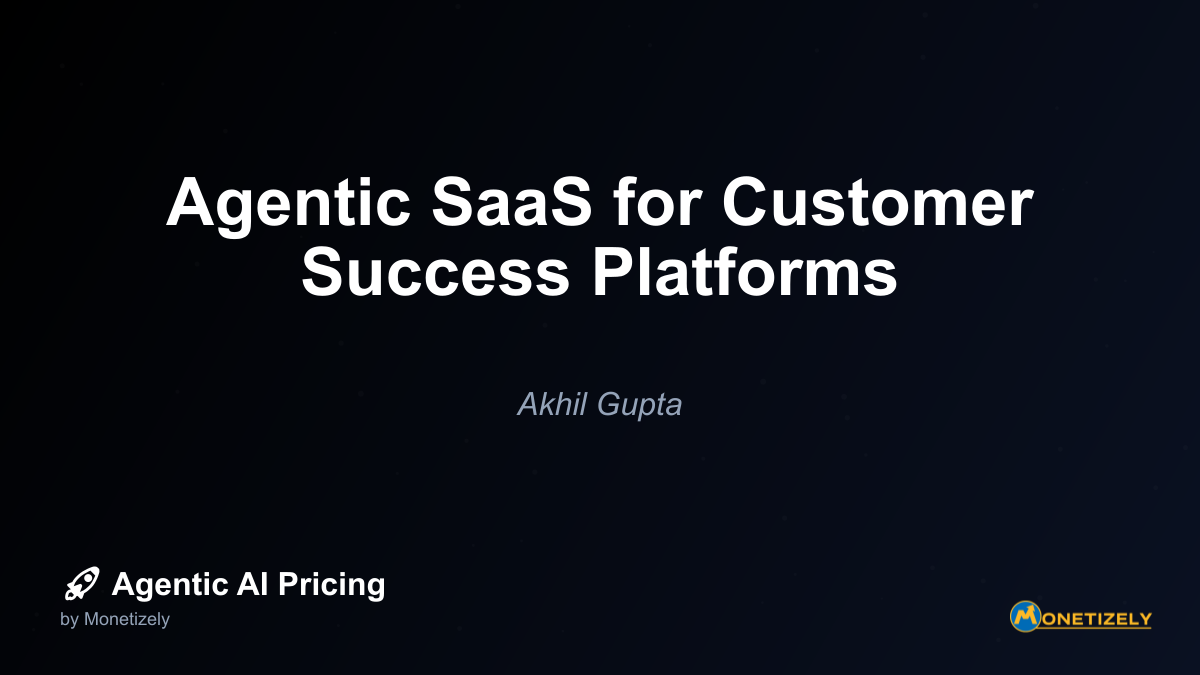· Akhil Gupta · Vertical Applications · 12 min read
Agentic SaaS in Cybersecurity
AI and SaaS Pricing Masterclass
Learn the art of strategic pricing directly from industry experts. Our comprehensive course provides frameworks and methodologies for optimizing your pricing strategy in the evolving AI landscape. Earn a professional certification that can be imported directly to your LinkedIn profile.
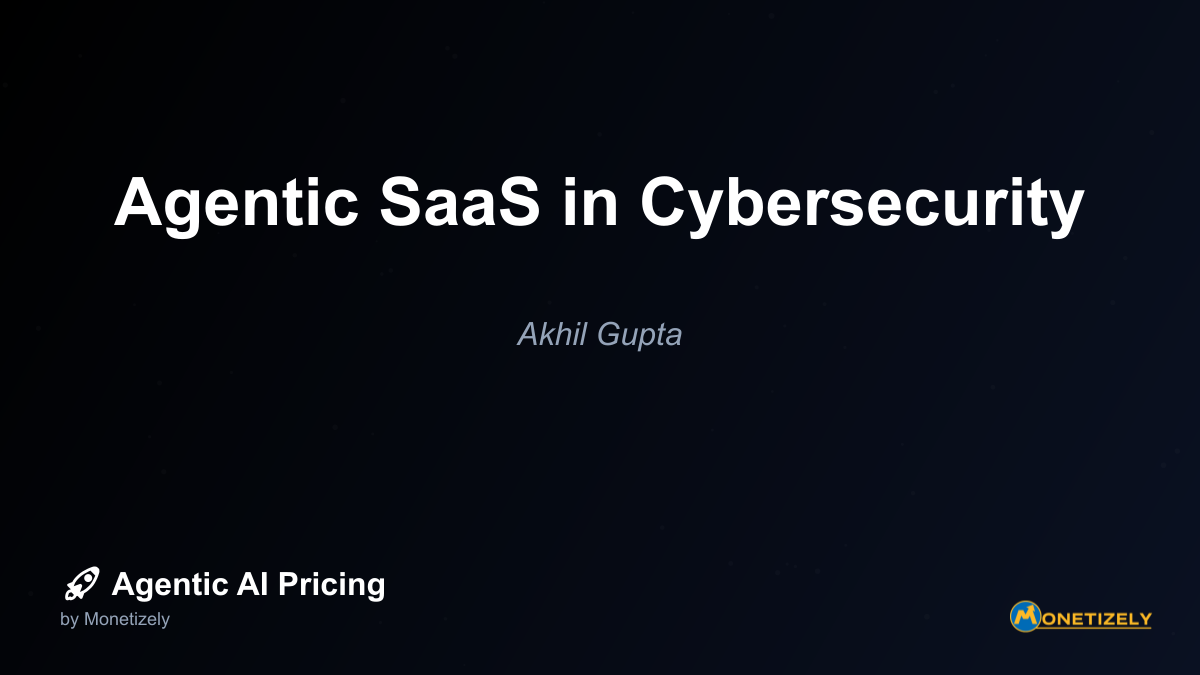
In today’s rapidly evolving digital landscape, cybersecurity threats have become more sophisticated, persistent, and damaging than ever before. Organizations face a constant barrage of attacks from various threat actors, ranging from opportunistic hackers to state-sponsored groups. Traditional security approaches, which rely heavily on human analysts and static rule-based systems, are struggling to keep pace with the volume, velocity, and complexity of modern threats. This has created a pressing need for more advanced, autonomous, and intelligent security solutions.
Enter agentic AI – a revolutionary approach to cybersecurity that leverages autonomous artificial intelligence agents to detect, analyze, and respond to threats with minimal human intervention. Unlike traditional AI systems that require constant human guidance, agentic AI systems can perceive their environment, make decisions, and take actions independently to achieve specific security objectives.
The Evolution of Cybersecurity: From Static Rules to Autonomous Agents
The cybersecurity landscape has undergone significant transformation over the decades. Initially, security measures relied on static signatures and rule-based detection methods that could only identify known threats. As attacks became more sophisticated, the industry evolved to incorporate machine learning algorithms that could detect anomalies and potentially identify novel threats.
However, these systems still required substantial human oversight and often generated overwhelming numbers of alerts, leading to alert fatigue among security teams. According to recent studies, security operations centers (SOCs) face significant challenges, with 63% of cyber teams spending more than four hours weekly investigating false positives alone.
The latest evolution in this journey is agentic AI – autonomous systems that can not only detect threats but also analyze their context, determine appropriate responses, and execute them with minimal human intervention. These systems represent a paradigm shift in how organizations approach cybersecurity, moving from reactive defense to proactive threat hunting and autonomous response.
Understanding Agentic AI in Cybersecurity
Agentic AI refers to AI systems that possess a degree of autonomy and agency in their operations. In the context of cybersecurity, these systems can:
- Autonomously detect threats by analyzing patterns across diverse data sources
- Contextualize alerts by correlating information from multiple security tools
- Determine appropriate responses based on the nature and severity of threats
- Execute remediation actions independently or with minimal human oversight
- Learn and adapt from new threats and previous interactions
These capabilities enable agentic AI systems to serve as tireless digital defenders that continuously monitor, analyze, and protect organizational assets around the clock.
Key Technical Components of Agentic AI Cybersecurity Systems
Agentic AI cybersecurity solutions are built on several advanced technical components:
Multi-Tier Agent Architecture
Most enterprise-grade agentic AI cybersecurity systems employ a tiered architecture:
- Tier 1 Agents: Handle initial detection and alert triage, filtering out false positives and categorizing potential threats
- Tier 2 Agents: Execute proactive containment actions such as isolating compromised endpoints or blocking suspicious traffic
- Tier 3 Agents: Perform in-depth threat hunting, vulnerability scanning, penetration testing, and malware analysis
This tiered approach allows for specialization among agents while maintaining a coordinated response to security incidents.
Advanced Machine Learning Models
Agentic AI systems leverage multiple AI/ML approaches:
- Supervised learning for classification of known threat patterns
- Unsupervised learning for anomaly detection and identifying novel threats
- Reinforcement learning to improve response strategies over time
- Deep learning for complex pattern recognition across large datasets
- Natural language processing for analyzing threat intelligence and security advisories
These models work in concert to provide comprehensive threat detection capabilities that can identify both known and unknown threats.
Chain of Thought Reasoning
A distinguishing feature of modern agentic AI systems is their ability to employ chain of thought reasoning – a process that mimics human analytical thinking by breaking down complex security problems into logical steps. This enables the system to:
- Trace the progression of potential attacks
- Identify causal relationships between seemingly unrelated events
- Explain its reasoning and decision-making process to human analysts
- Adapt its approach based on new information
This reasoning capability is particularly valuable for detecting advanced persistent threats (APTs) that unfold over extended periods and across multiple systems.
Integration with Existing Security Infrastructure
Agentic AI systems don’t operate in isolation but integrate with an organization’s existing security infrastructure, including:
- Security Information and Event Management (SIEM) systems
- Security Orchestration, Automation, and Response (SOAR) platforms
- Endpoint Detection and Response (EDR) tools
- Network monitoring solutions
- Threat intelligence feeds
This integration enables agentic AI to leverage existing security investments while providing an intelligent layer that coordinates and enhances the capabilities of these tools.
The Market Landscape: Key Players and Solutions
The agentic AI cybersecurity market is experiencing rapid growth, with both established security vendors and innovative startups offering solutions. According to Grand View Research, the global agentic AI cybersecurity market was valued at approximately $22.56 billion in 2024 and is projected to grow at a CAGR of 34.4% from 2025 to 2033, potentially reaching over $322 billion by 2033.
Major Players in the Agentic AI Cybersecurity Space
Darktrace
Darktrace’s Enterprise Immune System employs agentic AI to model normal network behavior and autonomously detect and respond to anomalies. Key features include:
- AI-driven anomaly detection with full network visibility
- Sophisticated alerting and autonomous response capabilities
- Comprehensive security analytics
- Flexible deployment options (on-premises, hybrid cloud)
Darktrace is particularly strong in network protection and has received positive user ratings (8.1/10 according to industry benchmarks). However, some users have noted integration limitations and occasional false positives.
CrowdStrike
CrowdStrike’s Falcon Platform leverages agentic AI for real-time endpoint protection:
- Cloud-native architecture enabling rapid, scalable deployment
- Intuitive interface with strong endpoint management
- Threat hunting and incident response capabilities
- Real-time protection and response
CrowdStrike is positioned as a premium solution targeting enterprises, with strong market presence (ranked #1 with an 8.6 rating and 14.1% mindshare in the XDR market). Users particularly appreciate its endpoint effectiveness and customer support.
SentinelOne
SentinelOne’s Singularity Platform offers:
- Endpoint detection and response with autonomous AI prevention
- Behavioral AI for multi-vector protection
- Anti-ransomware capabilities
- Cloud-based deployment with on-premises or hybrid options
SentinelOne has positioned itself as a top-tier competitor to CrowdStrike, with competitive pricing and strong protection rates. It’s particularly attractive for organizations seeking comprehensive EDR/NGAV with automation capabilities.
Microsoft
Microsoft Sentinel combines SIEM and SOAR capabilities with agentic AI:
- Cloud-native platform built on Azure
- Threat intelligence and behavioral analytics
- Automated incident response
- Seamless integration with the Azure ecosystem
Microsoft Sentinel is particularly cost-effective for Microsoft-centric environments, with pricing based on data ingestion volume and users. Its deep integration with Azure makes it a natural choice for organizations heavily invested in Microsoft technologies.
Other Notable Players
Several other vendors offer specialized agentic AI cybersecurity solutions:
- SOCRadar: Launched its Agentic Threat Intelligence platform in 2025, which autonomously detects, analyzes, and responds to threats with minimal human input
- IBM: Deploys AI-powered security orchestration tools that automate Level 1 and 2 SOC tasks
- Teramind: Focuses on insider threat detection and user behavior analytics
Pricing Models and Value Proposition
Agentic AI cybersecurity solutions typically command premium pricing due to their advanced capabilities and the significant value they deliver. Understanding the various pricing models and value propositions is essential for organizations evaluating these solutions.
Common Pricing Models
Tiered Subscription Plans
Most vendors offer tiered subscription models based on features and scale:
- Basic Tier: Core threat detection capabilities with limited autonomy
- Professional Tier: Enhanced detection, automated response for common threats, and integration with existing security tools
- Enterprise Tier: Full autonomous capabilities, advanced threat hunting, and customized response playbooks
These tiers allow organizations to start with basic functionality and scale up as they become more comfortable with agentic AI technology.
Usage-Based Pricing
Some vendors employ consumption-based pricing models:
- Per Endpoint: Charging based on the number of protected endpoints
- Data Volume: Pricing tied to the amount of data analyzed
- API Calls: Fees based on the number of API calls or queries to the AI system
Usage-based models provide flexibility but can be less predictable for budgeting purposes.
Value-Based Pricing
Innovative pricing approaches tie costs directly to value delivered:
- Outcomes-Based: Pricing linked to reductions in mean time to detection (MTTD) or containment (MTTR)
- Risk Reduction: Fees based on measurable reductions in security risk
- Threat Prevention: Charging for successful prevention of attacks that would have otherwise caused damage
These models align vendor incentives with customer security outcomes, potentially offering better ROI for organizations.
Justifying Premium Pricing
Vendors justify premium pricing for agentic AI cybersecurity solutions through several value propositions:
Task Complexity and Autonomy
Systems capable of handling complex security tasks with minimal human intervention command higher prices due to:
- Sophisticated AI models trained on vast security datasets
- Ability to handle edge cases and novel threats
- Reduced need for human analysts for routine tasks
Integration Capabilities
Solutions that seamlessly integrate with multiple systems (SIEM, SOAR, EDR, etc.) are priced higher due to:
- Reduced integration costs and complexity
- Enhanced visibility across security tools
- Elimination of data silos
Implementation and Total Cost of Ownership (TCO)
When evaluating agentic AI cybersecurity solutions, organizations must consider:
- Initial Investment: Software licensing, setup, and customization costs
- Ongoing Costs: Subscription fees, maintenance, and potential integration costs
- Scalability: Ability to scale up or down based on changing business needs
However, these costs must be weighed against potential savings:
- Reduced manual labor costs for security analysts
- Lower risk of successful breaches and associated costs
- Improved operational efficiency and faster incident response
Implementation Challenges and Best Practices
While agentic AI offers significant benefits for cybersecurity, implementing these solutions comes with several challenges that organizations must address.
Technical and Operational Challenges
Infrastructure Requirements
Deploying agentic AI requires robust infrastructure:
- High-performance computing resources (often GPU-accelerated)
- Scalable storage for large volumes of security data
- Low-latency networking for real-time threat detection and response
Organizations must ensure their infrastructure can support these requirements or consider cloud-based options that offload infrastructure management to the vendor.
Data Quality and Access
Agentic AI systems rely on high-quality data from diverse sources:
- Network traffic and logs
- Endpoint telemetry
- Cloud environment data
- External threat intelligence
- User behavior information
Ensuring clean, comprehensive data access across these sources can be challenging, especially in complex or siloed environments.
Integration with Legacy Systems
Many organizations operate legacy security tools that may not easily integrate with modern agentic AI solutions. This can create:
- Data gaps that limit AI effectiveness
- Workflow disruptions during implementation
- Potential security blind spots
Careful planning and phased implementation can help mitigate these challenges.
Organizational and Human Factors
Skills and Expertise
Successfully implementing and managing agentic AI requires specialized skills:
- AI/ML expertise for tuning and monitoring models
- Security knowledge to validate AI decisions
- Integration capabilities to connect with existing tools
Organizations often face skills gaps in these areas, requiring training or external expertise.
Change Management
Introducing autonomous systems can create resistance among security teams concerned about:
- Job displacement
- Loss of control over security operations
- Trust in AI decision-making
Effective change management and clear communication about how AI augments rather than replaces human expertise is essential.
Best Practices for Implementation
Phased Deployment Approach
A successful implementation typically follows progressive phases:
- Observation Mode: Deploy AI in monitoring-only mode to establish baselines and build trust
- Supervised Automation: Enable automated responses for low-risk scenarios with human approval
- Semi-Autonomous Operation: Allow independent action for well-understood threats with human oversight
- Full Autonomy: Gradually expand autonomous capabilities as confidence grows
This approach builds trust and allows for adjustment of AI parameters before granting extensive autonomous capabilities.
Human-in-the-Loop Design
Effective agentic AI systems maintain appropriate human oversight:
- Clear escalation paths for uncertain situations
- Transparent decision-making processes that analysts can review
- Override capabilities for human experts
- Continuous feedback mechanisms to improve AI performance
This collaborative approach leverages both machine speed and human judgment.
Continuous Evaluation and Improvement
Agentic AI systems require ongoing attention:
- Regular performance reviews against security objectives
- Model updates to address emerging threats
- Tuning to reduce false positives while maintaining detection capabilities
- Documentation of AI decisions and outcomes for audit purposes
This continuous improvement cycle ensures the system remains effective as the threat landscape evolves.
Case Studies: Real-World Applications
Examining real-world implementations provides valuable insights into how organizations are leveraging agentic AI for cybersecurity.
Financial Services: Autonomous Fraud Detection
A global financial institution implemented an agentic AI system to combat sophisticated fraud attempts:
Challenge: The organization faced increasingly complex fraud schemes that traditional rule-based systems couldn’t detect, resulting in significant financial losses.
Solution: Deployed a multi-tier agentic AI system that:
- Continuously monitored transaction patterns across multiple channels
- Autonomously identified anomalous behaviors indicative of fraud
- Automatically blocked suspicious transactions and escalated complex cases
- Learned from analyst decisions to improve future detection
Results:
- 78% reduction in fraud losses within six months
- 92% decrease in false positives compared to previous systems
- 65% reduction in analyst time spent on routine investigations
- Improved customer experience by reducing legitimate transaction blocks
Healthcare: Protecting Patient Data
A healthcare network implemented agentic AI to safeguard sensitive patient information:
Challenge: The organization needed to protect patient data across numerous systems while maintaining operational efficiency and regulatory compliance.
Solution: Deployed an agentic AI platform that:
- Monitored data access patterns across clinical and administrative systems
- Autonomously detected unusual access attempts or data exfiltration
- Implemented just-in-time access controls based on contextual factors
- Generated compliance reports with minimal human intervention
Results:
- Zero reportable data breaches since implementation
- 82% reduction in time spent on access reviews and compliance reporting
- Improved clinical workflow by reducing false access denials
- Enhanced compliance posture with automatic policy enforcement
Manufacturing: Defending Industrial Control Systems
A global manufacturer implemented agentic AI to protect critical industrial systems:
Challenge: The company’s operational technology (OT) networks faced increasing attacks that could potentially disrupt production or compromise safety.
Solution: Deployed specialized agentic AI that:
- Established baseline behavior for industrial control systems
- Autonomously detected anomalies without requiring OT protocol decryption
- Implemented segmentation and containment actions upon threat detection
- Coordinated response across IT and OT security teams
Results:
- Prevented three potential attacks that targeted industrial systems
- Reduced security incidents by 64% within the first year
- Maintained production continuity with zero security-related disruptions
- Improved visibility across previously isolated OT environments
Ethical Considerations and Risks
The deployment of autonomous AI systems in cybersecurity raises important ethical considerations and potential risks that organizations must address.
Security Risks of Agentic AI
AI System Vulnerabilities
Agentic AI systems themselves can become targets:
- Data Poisoning: Attackers may attempt to corrupt training data to mislead AI decisions
- Model Extraction: Adversaries might try to steal AI intellectual property
- Prompt Injection: Sophisticated attacks could manipulate AI inputs to reveal sensitive information or execute malicious commands
Organizations must implement robust protections for their AI systems, including secure development practices, continuous monitoring, and rigorous testing.
Expanded Attack Surface
Autonomous agents can inadvertently create new vulnerabilities:
- Shadow AI Agents: Unauthorized or unmonitored AI deployments operating without proper oversight
- Privilege Escalation: Agents with excessive system access that could be compromised
- Insider Threat Potential: Compromised AI agents could act as insider threats with extensive system access
Strict governance frameworks and access controls are essential to mitigate these risks.
Ethical Considerations
Autonomy and Accountability
Autonomous decision-making raises questions about:
- Who is responsible when AI actions cause unintended consequences?
- How to ensure appropriate human oversight without negating AI benefits
- What limits should be placed on autonomous actions in high-risk scenarios
Clear governance frameworks with defined accountability structures are necessary to address these concerns.
Privacy and Data Protection
Agentic AI typically requires access to sensitive data:
- Employee communications and activities
- Customer information and transactions
- Intellectual property and business operations
Organizations must balance security needs with privacy considerations, implementing data minimization, anonymization, and strict access controls.
Regulatory Compliance
Emerging regulations increasingly focus on AI governance:
- Transparency requirements for automated decision-making
- Mandates for human oversight of critical AI systems
- Data protection regulations that limit automated processing
Organizations must stay informed about evolving regulatory requirements and ensure their agentic AI deployments remain compliant.
Mitigation Strategies
Co-Founder & COO
Akhil is an Engineering leader with over 16+ years of experience in building, managing and scaling web-scale, high throughput enterprise applications and teams. He has worked with and led technology teams at FabAlley, BuildSupply and Healthians. He is a graduate from Delhi College of Engineering and UC Berkeley certified CTO.
Pricing Strategy Audit
Let our experts analyze your current pricing strategy and identify opportunities for improvement. Our data-driven assessment will help you unlock untapped revenue potential and optimize your AI pricing approach.

